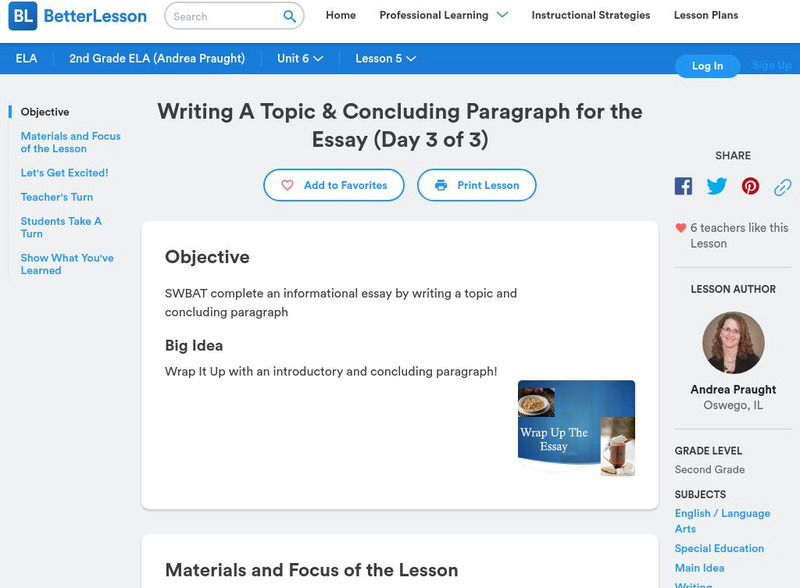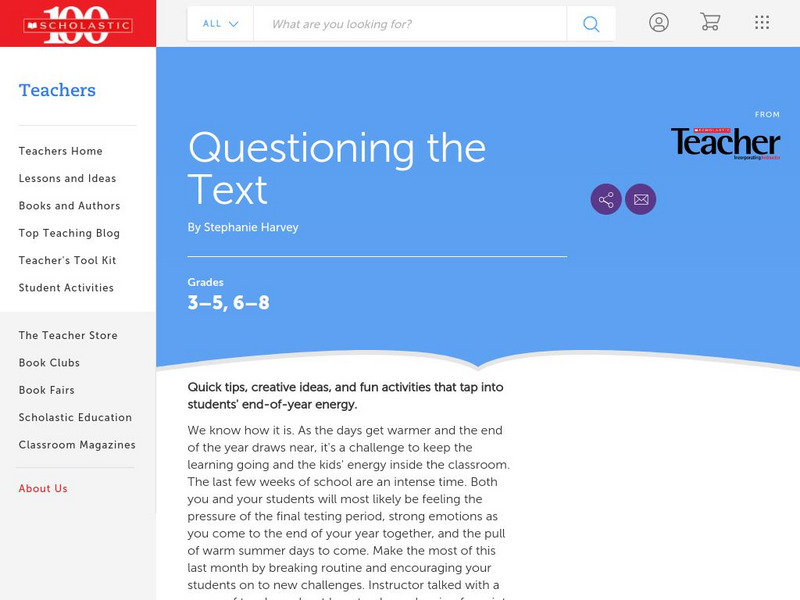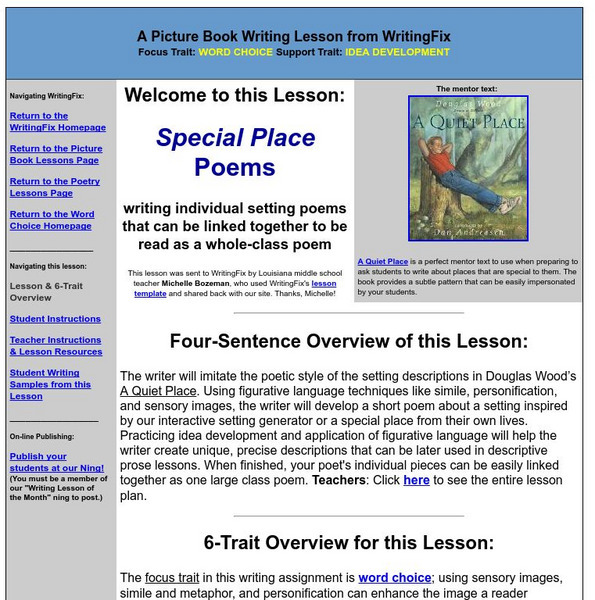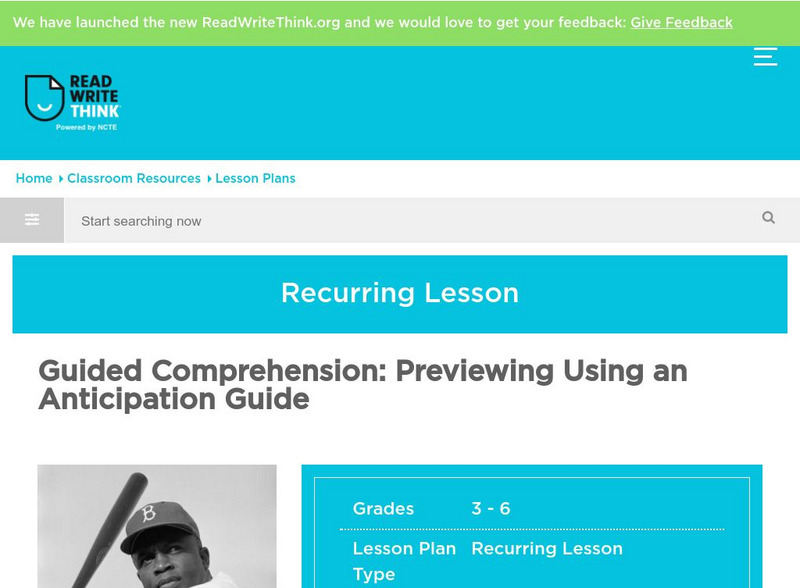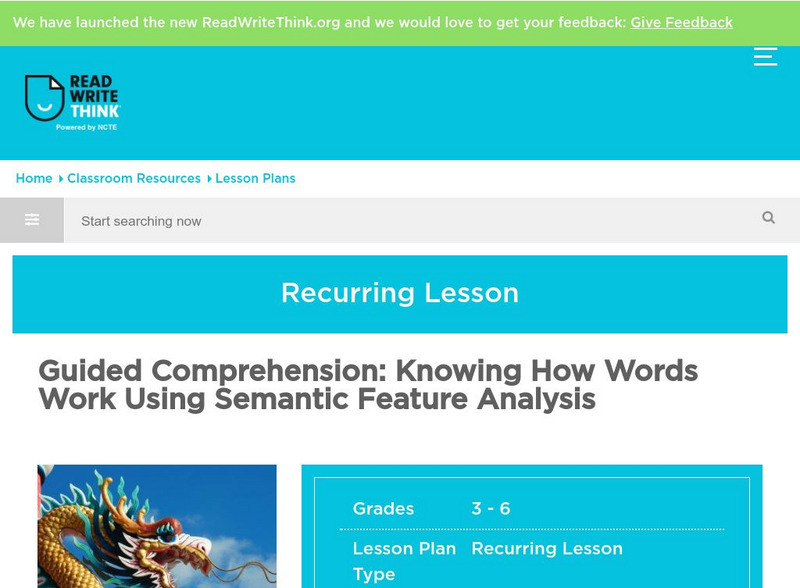ReadWriteThink
Read Write Think: Literature Circles Getting Started
Contains plans for nine lessons to help teachers start using literature circles in the classroom, including detailed explanations of all the roles and procedures. In addition to objectives and standards, this instructional plan contains...
Read Works
Read Works: Lesson 2: First and Last Sentences (Passage)
[Free Registration/Login Required] Students comprehension will be reinforced as they reading first and last sentences of paragraphs. Direct teaching, guided practice, and independent worksheets are available for this third grade lesson.
Better Lesson
Better Lesson: Speaking and Listening: Collaborative Conversations
Students will partner read The Kite, by Alma Flor Ada. Then work together in small collaborative groups to describe the character of the mother, the children, or the kitten. Included in this lesson are video demonstrations, printable...
Library of Congress
Loc: Photo Analysis Presenting the Statue of Liberty
The ability to examine a primary source is a gateway to building critical thinking skills and constructing knowledge. This lesson provides the students an opportunity to observe similarities and differences between 2 visual images,...
Better Lesson
Better Lesson: Writing a Topic & Concluding Paragraph for the Essay
This lesson is a final step towards supporting young scholars to practice writing an informative/explanatory paragraph conveying complex ideas and presenting information clearly and accurately. Second-grade students can usually write a...
Better Lesson
Better Lesson: Shared Inquiry Discussion
Students learn to generate ideas with a clear focus in response to questions while participating in a shared inquiry discussion. Included are shared inquiry guidelines, and tips on discussing fiction and non-fiction books using this method.
Reading Rockets
Reading Rockets: Reading Basics: Sounds of Speech
Sounds of speech are the sounds that make up our oral language. Children must understand how speech sounds work to be ready for instruction in reading and writing. To learn more about sounds of speech, browse the articles, parent tips,...
BBC
Bbc Skillswise: Listening for Specific Information
This tutorial presents a video, factsheets, and worksheets for learning how to listen for and understand information. It looks at how to handle different situations, e.g., arranging a delivery, asking questions about a product before...
Reading Rockets
Reading Rockets: Building Background Knowledge
The importance of background knowledge is especially salient in the age of Common Core. This article offers practical classroom strategies to build background knowledge such as using contrasts and comparisons and encouraging...
Better Lesson
Better Lesson: Researching a Topic: Teaching Students to Research Information
Students will conduct a short research project about a topic. This lesson focuses on how to find the information needed on their chosen topic.
Quia
Quia: Reading Comprehension (Reading for Facts)
There are 30 questions in this activity. Practice your reading skills with one or two short stories at a time. Read the story, then choose the answer that best answers the question.
FNO Press
Fno.org: Inspired Investigations
An article at From Now On about how to help students do better research by changing the focus of research assignments and teaching students to ask essential questions. Some suggestions include using mind mapping, and using Inspiration to...
Michigan State University
Michigan State University: Interventions for Reading Strategies: Qar Strategy
This Michigan State University site suggests three question-answer relationships strategies, rather than four, leaving out "author and you." Includes examples of each relationship, steps for teaching, and assessment.
Scholastic
Scholastic: Questioning the Text
In this magazine article originally featured in Instructor, the reading strategy called "questioning the text" is explained by the renowned literacy consultant and staff developer, Stephanie Harvey. The steps included for questioning the...
Writing Fix
Writing Fix: A Picture Book Writing Lesson: Start With What Isn't There
In this lesson plan, learners will describe a setting, attempting to set a mood for their readers in two paragraphs. Borrowing a technique from Stephen Kramer's two-page introduction to Caves, they will begin with a paragraph that...
Writing Fix
Writing Fix: Purposeful Paragraphs on Memorable Teachers [Pdf]
How can we use questioning to create lead sentences and details in order to create a purposeful paragraph? This PDF lesson offers an organization technique that asks young scholars to pre-plan paragraphs by brainstorming interesting...
Writing Fix
Writing Fix: Special Place Poems
In this lesson students will develop a poem while thinking about a special place. They will develop their ideas using strong word choice and figurative language. After the students have completed their ideas, they will be linked together...
Curated OER
Mc Graw Hill: Part 1: Reading Literature: Show Understanding of Text
This quick lesson from the Common Core Literacy eHandbook teaches students what questions to ask and how to answer questions to show your understanding of literature.
Curated OER
Mc Graw Hill: Part 2 Reading: Informational Text: Show Understanding of Text
This quick activity includes a passage from an information text, and explains reading comprehension strategies to use to answer questions.
Other
Reading Educator: Question Answer Relationships
Based on the presumption that every teacher shares responsibility for teaching reading, this page offers a brief look at question-answer relationships, as well as suggestions for putting the strategy to use in the classroom.
ReadWriteThink
Read Write Think: Guided Comprehension: Previewing
This lesson introduces students to the comprehension technique of previewing. Students use anticipation guides to preview and predict stories and work in small groups.
ReadWriteThink
Read Write Think: Guided Comprehension: Making Connections
Lesson introduces young scholars to the strategy of making connections. Students learn the three types of connections using a double-entry journal. A good resource for teachers.
ReadWriteThink
Read Write Think: Guided Comprehension: Semantic Analysis
Lesson introduces learners to comprehension of knowing how words work. Students learn semantic feature analysis and examine folktales, myths, and fables using this analysis to better understand these terms and texts.
ReadWriteThink
Read Write Think: Guided Comprehension: Evaluating
This lesson introduces students to the comprehension strategy of evaluating. Students learn this strategy through the "meeting of the minds" technique that teaches them to act out opposing views of two or more characters.






